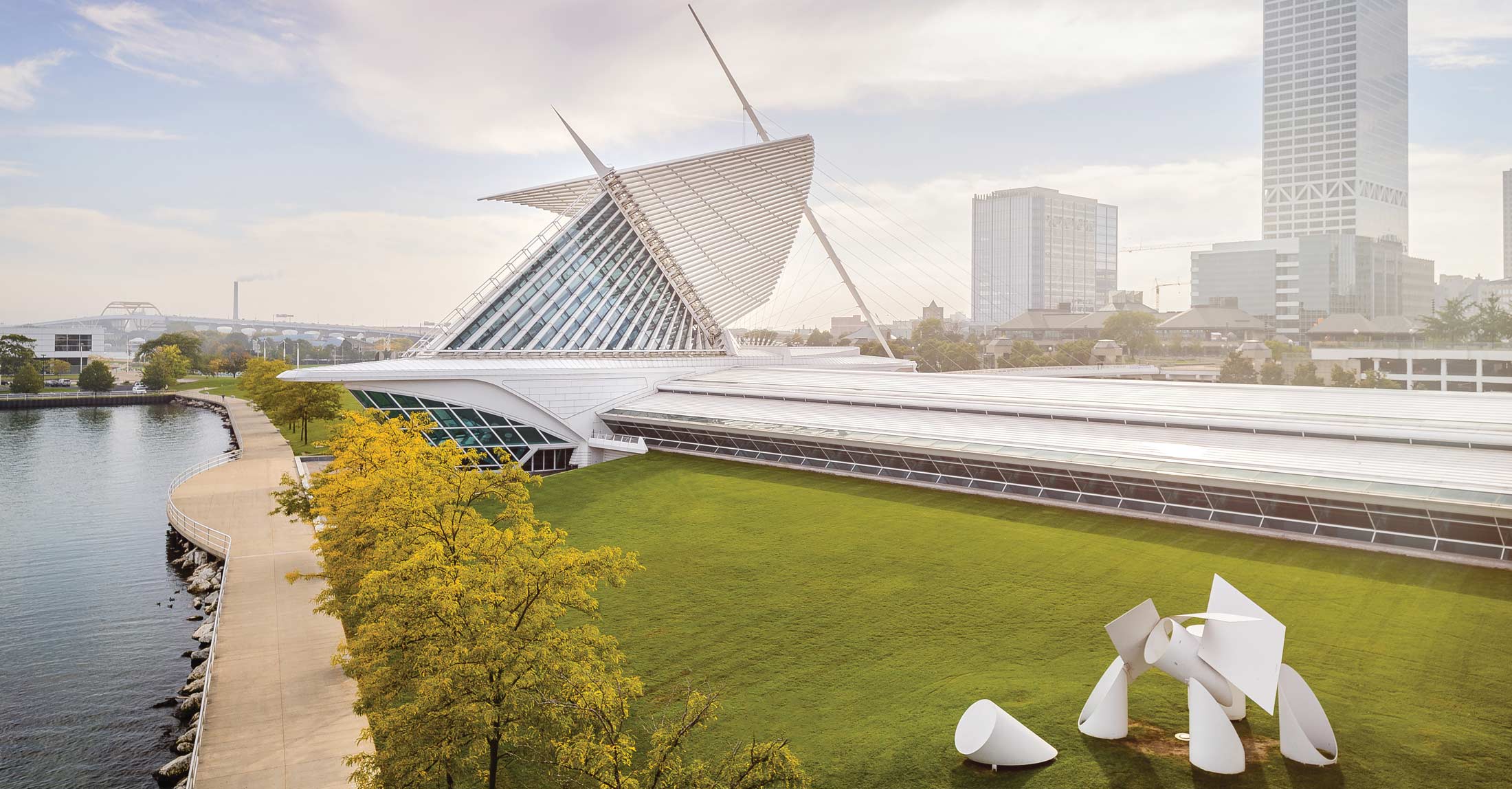Milwaukee Art Museum Celebrates 3,000 Years of Chinese Art and Culture during the Summer of CHINA
Acclaimed The Emperor’s Private Paradise featured in exhibition series
Milwaukee, Wis. – This summer, the Milwaukee Art Museum presents five exhibitions on Chinese art and architecture as part of a year-long celebration honoring the ten-year anniversary of the Santiago Calatrava–designed Quadracci Pavilion. This ambitious exhibition schedule explores three thousand years of Chinese art, and Mayor Tom Barrett has, in turn, declared this summer to be the “Summer of China” in the City of Milwaukee.
The Museum’s feature exhibition for the summer is The Emperor’s Private Paradise: Treasures from the Forbidden City, on through Sunday, September 11, 2011. The Museum is one of only three museums in the world to showcase over ninety objects of ceremony and leisure from the Qianlong Garden and the Forbidden City in Beijing, never before seen by the public.
A two-acre jewel in the immense 180-acre Forbidden City complex, the Qianlong (pronounced chee’en lohng) Garden is praised for its unique combination of Northern and Southern Chinese garden design elements and interiors. Built in the eighteenth century, the garden complex was part of the Qianlong Emperor’s ambitious twelve-acre retreat, commissioned in anticipation of his retirement. Buddhist shrines, open-air gazebos, sitting rooms, libraries, theaters, and gardens were interspersed with bamboo groves and other natural arrangements. In the garden’s worlds within worlds, the Qianlong Emperor would retreat from affairs of state and meditate in closeted niches, write poetry, study the classics, and delight in his collection and artistic creations.
The garden sat dormant after the last emperor, PuYi, left the Forbidden City in 1924, and the items in it remained unaltered since the end of the Qianlong Emperor’s reign in 1795. In 2001, the Palace Museum and World Monuments Fund (WMF) began the restoration of the Qianlong Garden’s 27 buildings, pavilions, and outdoor elements, including ancient trees and rockeries.
Now for the first time, these objects, including murals, paintings, furniture, architectural and garden components, jades, and cloisonné arts, will leave the sanctity of the Qianlong Garden. The Museum is the last destination for The Emperor’s Private Paradise: Treasures from the Forbidden City, before the objects return to China.
“This is an extraordinary, unprecedented opportunity for the public to see masterpieces from the legendary Forbidden City complex before the objects return to Beijing where they will likely never leave the country again,” said Daniel Keegan, director of the Milwaukee Art Museum. “We are honored to be one of only three museums worldwide to present this breathtaking exhibition. It reaffirms our commitment to bringing world-class exhibitions to Milwaukee, and underscores the importance of the Milwaukee Art Museum on the international stage.”
While the objects are in the United States, the Palace Museum and WMF are restoring structures within the Qianlong Garden, and the objects will be permanently housed there. The internationally funded project is expected to be completed by 2019.
The Emperor’s Private Paradise: Treasures from the Forbidden City was organized by the Peabody Essex Museum in partnership with the Palace Museum and in cooperation with the World Monuments Fund and has been made possible through generous support from the Mandarin Oriental Hotel Group and American Express. Additional support was provided by the E. Rhodes and Leona B. Carpenter Foundation, the National Endowment for the Arts, and by ECHO (Education through Cultural and Historical Organizations), a program of the U.S. Department of Education.
Four additional exhibitions of Chinese art and architecture will be on view during the Museum’s Summer of CHINA celebration.
“The Museum’s curatorial team has worked tirelessly to bring together a collection of significant modern and ancient Chinese art to share with our visitors,” said Laurie Winters, director of exhibitions for the Milwaukee Art Museum. “The historical significance of the Summer of CHINA is substantial.”
Although not designed as a comprehensive survey, the Summer of CHINA provides a sweeping overview of dynastic art through the centuries, as it explores underlying themes of transformation, innovation, and the technological advances made in various mediums at different periods in Chinese history. A detailed schedule of programming accompanies the exhibition series. For more information, visit mam.org/china.
SCHEDULE OF SUMMER OF CHINA EXHIBITIONS
The Emperor’s Private Paradise: Treasures from the Forbidden City (June 11, 2011–September 11, 2011) includes over ninety objects of ceremony and leisure from the Qianlong Emperor’s private garden, deep within the Forbidden City. These never-before-seen murals, paintings, furniture, architectural and garden components, jades, and cloisonné reveal the contemplative life and refined vision of one of history’s most influential rulers with artworks from one of the most significant places in the world.
Warriors, Beasts, and Spirits: Early Chinese Art from the James Conley Collection (June 11, 2011–September 11, 2011) highlights include Han and Tang vessels, sculptures as well as accouterments of exquisite carvings in jade, lacquer, wood, bronze, and large-scale architectural components from the Ming period. Lent by James E. Conley, Jr., this large display of more than 40 works of art offers a rare opportunity to view remarkable objects drawn from nearly 3,000 years of China’s creative inspiration.
Emerald Mountains: Modern Chinese Ink Painting from the Chu-tsing Li Collection (June 11, 2011–August 28, 2011) will explore the development of Chinese ink painting during the second half of the 20th century. Drawn from the Chu-tsing Li collection of modern Chinese paintings—the finest and most comprehensive of its kind in the West—these extraordinary paintings demonstrate the reinvigoration of classical techniques and materials by artists throughout Mainland China, Taiwan, Hong Kong, and abroad working with distinctly contemporary perspectives.
On Site: Zhan Wang (June 11, 2011–September 11, 2011) will highlight the new world and the old world in a contemporary setting. Zhan Wang has become world famous for his stainless steel copies of “scholars’ rocks” found in classical Chinese gardens. To him, both the original rock and his stainless copy are material forms created for people’s spiritual needs; their different materiality suits different cultural environments at different times.
Way of the Dragon: The Chinoiserie Style, 1710–1830 (June 30, 2011–November 6, 2011) explores how chinoiserie developed, and subsequently degenerated in the eighteenth century. The exhibition investigates and questions the European perceptions of China through decorative arts.
SPONSORS FOR THE SUMMER OF CHINA
The Milwaukee Art Museum’s Summer of CHINA is presented by BMO Financial Group, Bucyrus, Concordia University Wisconsin, Harley-Davidson Motor Company® and The Harley-Davidson Foundation, Johnson Controls, The Lai Family Foundation, and Rockwell Automation. Additional support is provided by Baird, Brady Corporation, Einhorn Family Foundation, Foley & Lardner LLP, The Freeman Foundation, and M&I Wealth Management, with media sponsorship provided by the Milwaukee Journal Sentinel and Time Warner Cable.
ABOUT THE PALACE MUSEUM
The Palace Museum was established on October 10, 1925, in the Forbidden City (the palace of the Ming and Qing Dynasties), and houses its collection of treasures. It is a large, comprehensive national museum that embraces the palatial architectural complex, ancient art, and imperial court history. The Palace Museum is dedicated to the conservation of its ancient architecture, collections, and ancient court history through archiving, research, and display so that people from all walks of life may enjoy them.
ABOUT WORLD MONUMENTS FUND
WMF is an international historic preservation organization founded in 1965 and based in New York City. For 45 years, WMF has worked to save and preserve endangered historic sites in all part of the world. These have ranged from iconic sites such as the temples of Angkor, Cambodia, to lesser-known but emblematic ones, such as Marie Antoinette’s private theater in Versailles. (See www.wmf.org)
ABOUT THE MILWAUKEE ART MUSEUM
The Milwaukee Art Museum’s far-reaching holdings include more than 25,000 works spanning antiquity to the present day. With a history dating back to 1888, the Museum houses a collection with strengths in 19th- and 20th-century American and European art, contemporary art, American decorative arts, and folk and self-taught art. The Museum includes the Santiago Calatrava-designed Quadracci Pavilion, named by Time magazine as “Best Design of 2001.” For more information, please visit www.mam.org.
ADDITIONAL PROGRAMMING FOR THE SUMMER OF CHINA
MAM AFTER DARK: CHINA
Friday, June 10, 5 p.m.–midnight
Be the first to experience this realm of majesty and mystery through curator-led tours.
Details and advance admission at www.mam.org/afterdark.
LECTURE: THE SURVIVAL AND REVIVAL OF THE EMPEROR’S VISION: THE RESTORATION OF THE QIANLONG GARDEN
Sunday, June 12, 1:30 p.m.
Henry Ng, Executive Vice President, World Monuments Fund
Sponsored by the Fine Arts Society
LAKEFRONT FESTIVAL OF ARTS
Friday–Sunday, June 17–19, 2011
This year’s annual event includes five artists from China, as well as indoor and outdoor vendors, food, music, kids activities, and more. For more information, visit http://lfoa.mam.org/.
LECTURE: WARRIORS, BEASTS, AND SPIRITS FOR ETERNITY: BURIAL PRACTICES IN EARLY CHINA
Thursday, June 23, 6:15 p.m.
Katheryn Linduff, Professor in the History and Art and Archaeology at the University of Pittsburgh
Sponsored by the Fine Arts Society
LECTURE: THE MAN AND HIS IMAGE: QIANLONG’S IMPERIAL PROPAGANDA AND ARTISTIC PURSUITS
Thursday, June 30, 6:15 p.m.
Eugenio Menegon, Professor of History at Boston University
Sponsored by the Fine Arts Society
KOHL’S ART GENERATION FAMILY SUNDAYS | CHINESE TREASURES
Sunday, July 17, 10 a.m.–4 p.m.
LECTURE: CONTEMPORARY CHINESE ART
Thursday, July 21, 6:15 p.m.
Melissa Chiu, Museum Director and Curator for Contemporary Asian and Asian-American art
Sponsored by the Contemporary Arts Society
CHINESE CULTURAL FESTIVAL
Saturday and Sunday, July 23–24, 2011
Experience art, music, food, entertainment, shopping, and more during this two day event, sponsored by the Milwaukee Chinese Community Center
LECTURE: PALACE TANTRA: EMPEROR QIANLONG’S FASCINATION WITH TIBETAN BUDDHISM
Thursday, August 4, 6:15 p.m.
John Johnston, Coates-Cowden-Brown Curator of Asian Art at the San Antonio Museum of Art
Sponsored by the Fine Arts Society
LECTURE: THE WILD WILD EAST: CHINA’S CONTEMPORARY ART SCENE
Thursday, August 11, 6:15 p.m.
Barbara Pollack, author of The Wild, Wild East: An American Art Critic’s Adventures in China
Sponsored by the Fine Arts Society
LECTURE: MONSTROUS BEAUTY: THE CHINESE STYLE IN THE NEOCLASSICAL AGE
Thursday, August 25, 6:15 p.m.
David Porter, Associate Professor of English and Comparative Literature at the University of Michigan
Sponsored by the American Arts Society and the Chipstone Foundation
###


